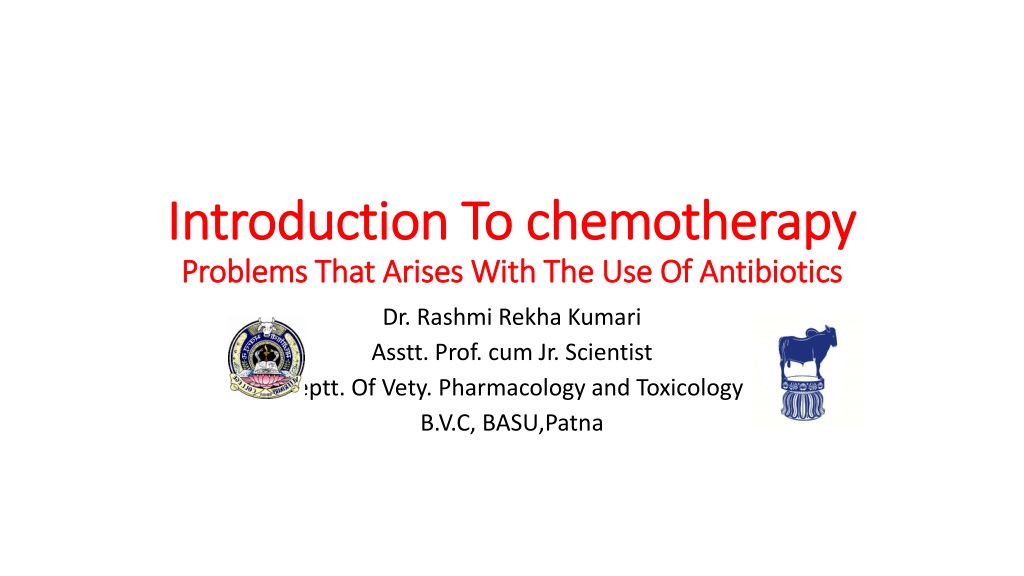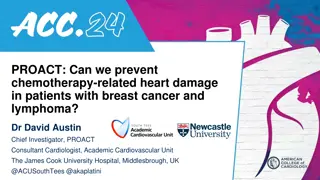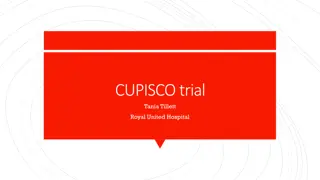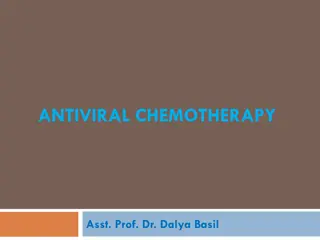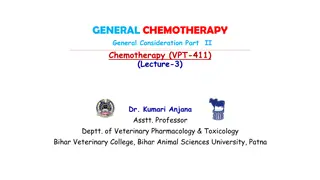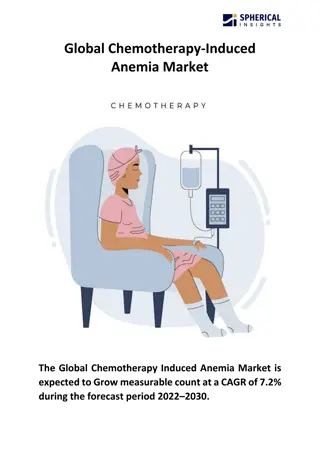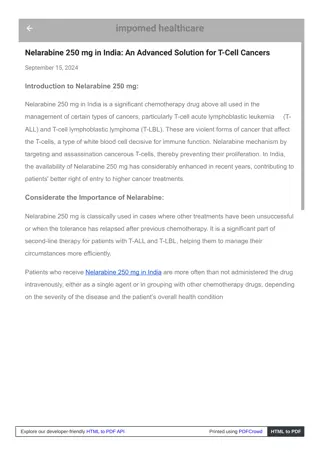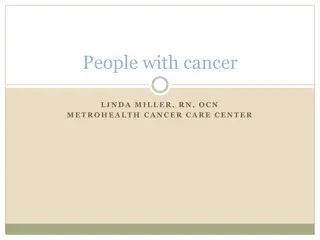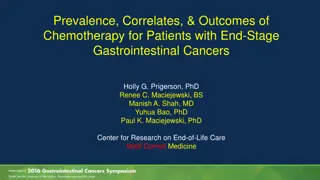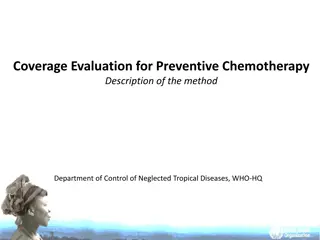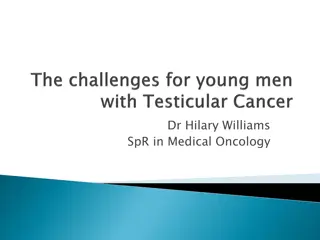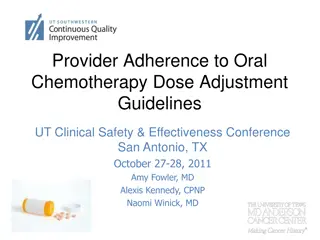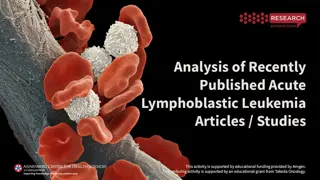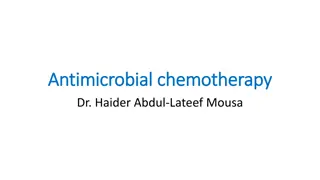Introduction To chemotherapy Introduction To chemotherapy
Chemotherapy involves the use of antibiotics, but various problems can arise such as toxicity, drug resistance, hypersensitivity reactions, and more. Antibiotics can cause local irritancy, systemic toxicities, and impact different body systems. Understanding these issues is crucial for effective treatment.
Download Presentation

Please find below an Image/Link to download the presentation.
The content on the website is provided AS IS for your information and personal use only. It may not be sold, licensed, or shared on other websites without obtaining consent from the author. Download presentation by click this link. If you encounter any issues during the download, it is possible that the publisher has removed the file from their server.
E N D
Presentation Transcript
Introduction To chemotherapy Introduction To chemotherapy Problems That Arises With The Use Of Antibiotics Problems That Arises With The Use Of Antibiotics Dr. Rashmi Rekha Kumari Asstt. Prof. cum Jr. Scientist Deptt. Of Vety. Pharmacology and Toxicology B.V.C, BASU,Patna
Problems That Arises With The Use Of Problems That Arises With The Use Of Antibiotics Antibiotics Toxicity- Local irritancy & Systemic toxicity Hypersensitivity reaction Drug resistance Superinfection Nutritional Deficiencies Masking of an infection
Toxicity Toxicity Local irritancy: Practically all antimicrobial agents, especially erythromycin, tetracyclines and certain cephalosporins and chloramphenicol are irritants Systemic toxicity Drugs having Very Low Therapeutic Index: Used in condition where no suitable alternative is available Drug Toxicity PolymyxinB Neurological and renal Toxicity Vancomycin Amphotericin B Kidney, Bone marrow and neurological toxicity Hearing loss, Kidney damage
Drugs having lower therapeutic index Drugs Toxicity 8thcranial nerve and kidney toxicity Aminoglycosides Tetracyclins Liver and kidney damage,antianabolic effect chloramphenicol Bone marrow depression Drugs having high therapeutic index: doses upto 100 foldrange may be given without appartent damage to host cell Example: Penicillin, Erythromycin, cephalosporin
Hypersensitivity/Allergic reaction Hypersensitivity/Allergic reaction These are unpredictable and unrelated to dose The whole range of reaction from harmless rashes to severe reaction (anaphylactic shock, haemolysis,allergic liver damage and bone marrow depression) can be produced. The most commonly involved AMAs are-penicillins, cephalosporins, sulphonamides and fluoroquinolones Penicillin, the commonest cause of drug induced anaphylaxis, produce this response in an estimated 1 in 50,000 patient exposed Some example of haemolytic reactions are: haemolytic anaemia(sulphonamide), agranulocytosis(sulphonamide, chloramphenicol
Drug Resistance Drug Resistance It refers to unresponsiveness of a microorganism towards an AMA. Natural Resistance: Some microorganism have always been resistant to certain AMA. Example: Gram ve bacilli are generally unaffected by Penicillin G. Anaerobic bacteria are resistant to gentamycin. Acquired Resistance: It is development of resistance by microorganism (which was sensitive before) due to use of an AMA over a period of time. This can happens with any microbes and is a major clinical problem Development of resistance is dependent on the microorganism as well as on drug Some bacteria are notorious for rapid acquisition of resistance eg; staphylococci, coliforms, tubercle bacilli. While Strept. Pyogens have not developed significant resistance to penicillin even widespread use for > 50 years.
Development of resistance Development of resistance Resistence may be developed by mutation or gene transfer Mutation: Stable and heritable genetic change that occur that occurs spontaneously and randomly among microorganism.
Mutation and resistance may be i) Single step ii) Multistep Single step: A single gene mutation may confer high degree of resistance; emerges rapidly, e.g. Enterococci to streptomycin, E.coli and Staphylococci to rifampin Multistep: A number of gene modification are involved; sensitivity decreases gradually in a stepwise manner. Resistance to erythromycin, tetracyclines and chloramphenicol is developed by many organism in this manner Sometimes mutational acquisition of resistance is accompanied by decrease in virulence.
Antibiotic resistance in bacteria spreads at three levels Antibiotic resistance in bacteria spreads at three levels By transfer of bacteria between people By transfer of resistance gene between bacteria (usually on plasmids) By transfer of resistance gene between genetic elements within bacteria, on transposons Plasmids :are extrachromosomal genetic element that can replicate independently and can carry gene coding for resistance to antibiotics. Such plasmids refered as R plasmid. The main method of transfer of R gene from one bacterium to other is by conjugative plasmid, which can cause the bacterium to make connecting tube between bacteria through which plasmid itself can pass.
Gene transfer Gene transfer Resistance may also occure by horizontal transfer of r gene between the bacteria by i) conjugation ii) Transduction iii) transformation Conjugation: Sexual contact through the formation of a bridge or sex pilus is common among gram ve bacilli of the same or another sp. This may involve chromosomal or extrachromosomal (plasmid) DNA The gene carrying the resistance or R factor is transferred only if another resistance transfer factor is also present. Conjugation frequently occur in colon where large variety of gram negative bacteria come in close contact. Even non-pathogenic organism may transfer R factor to pathogenic organism which may become widespread by contamination of food or water.
A less common method of transfer of R gene is by Transduction i.e. the transfer of an r-gene carrying plasmid into a bacterium by a bacteriophage. The R factor is taken up by bacteriophage and delivered to another bacterium which it infect Many Staph aureus strain have acquired resistance by transduction Transformation: A resistant bacterium may release the resistance carrying DNA into the medium and this may be imbibed by another sensitive strain becoming unresponsive to drug. This mechanism have no clinical significance.
Resistant organism can be of thee type Resistant organism can be of thee type- - Drug tolerant: Loss of affinity of target biomolecule of the microorganism for a particular AMA. e.g., certain penicillin resistant pneumococcal strains have altered penicillin binding proteins. Drug destroying: Resistant microorganism elaborate an enzyme which inactivate the drug. Beta lactamase for lactam antibiotics, Acetyl transferase which inactivate chloramphenicol, Kinases inactivates Aminoglycosides. Drug impermeable: Many hydrophilic antibiotics gain access into the bacterial cell through specific channel formed by protein called porins or need specific transport mechanism. These may be lost by the resistant strain. Bacteria may aquire plasmid directed efflux protein in their cell membrane.
Prevention of drug resistance Prevention of drug resistance No indiscriminate and inadequate or unduly prolonged use of AMAs should be made. Prefer rapid acting and selective(narrow spectrum) AMA whenever possible Use combination of AMAs whenever prolonged therapy is undertaken, e.g. tuberculosis, SABE. Infection by organism notorious for developing resistance, e.g. Staph aureus, E. coli, M. tuberculosis, Proteus etc must be treated extensively.
